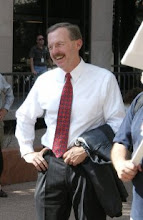 A World War I-era Terror Plot Hatched Downtown
A World War I-era Terror Plot Hatched DowntownJacques Kelly
Baltimore Sun
January 30, 2010
The father and son enjoying lunch at the Maryland Club in 1915 would not have attracted any attention. The Hilkens, Henry and Paul, were pillars of Baltimore's German community. The son, Paul Hilken, ran the Baltimore operations of the North German Lloyd Steamship Co., as his father did before him. The elder Hilken was such an outstanding citizen that his 1937 obituary called him "the dean of the local shipping men," and Baltimore Mayor Howard Jackson and the German ambassador were honorary pallbearers. But what no one knew in 1915 was that Paul Hilken was working as a German spy.
I've recently been reading of this little-recalled enemy conspiracy with deep Baltimore roots. Paul Hilken was the paymaster for a World War I German espionage-terrorism ring responsible for blowing up, spectacularly, a New York harbor arms depot, among other acts of terrorism. His name turns up in Nicholas Thompson's new book, "The Hawk and the Dove," because he was the uncle and namesake of U.S. diplomat Paul Nitze. The author led me to Chad Millman's 2006 work, "The Detonators." I had already read Jules Witcover's "Sabotage at Black Tom."
This is the account that Millman and Witcover give:
Paul Hilken, a Baltimorean, was educated at City College, Lehigh and MIT, where he studied shipbuilding. While working here, he was being groomed to become the managing director of the North German Lloyd line in New York. Summoned to the Reichstag in Berlin and tapped for undercover work, he accepted readily.
His Baltimore office was the quaint, nicely preserved Hansa Haus at the northwest corner of Charles and Redwood streets. (Redwood's former name was German Street; the name change came during a burst of patriotism during World War I.) His clandestine meetings were held in its attic in private quarters. His German handlers chose him because he regularly handled huge amounts of currency, and money could pass through the doors of 2 E. Redwood St. with no questions asked.
The U.S. was then technically a neutral nation, but it was an open secret that we were supplying the Allied countries with explosives. Millions of pounds were awaiting transfer to ships anchored in Gravesend Bay in New York's harbor. The ammunition was stored at the Black Tom piers in Jersey City. Paul Hilken paid off operatives with $1,000 bills. After meeting for three hours on Redwood Street, the conspirators agreed the fires should start early on July 30, 1916. The resulting Black Tom explosions killed at least five people. Concussions could be felt in Maryland.
Germany denied all responsibility, citing evidence that fires were started by rail yard watchmen using smoke to keep down mosquitoes.
After the end of World War I, the legal fighting began (damage estimates were $20 million), and it continued for an agonizing 18 years at the Mixed Claims Commission in Washington.
Hilken, who was never charged, was a major sinner but also a saint. He provided state's evidence, but it was his word against those who called him a liar. He testified for hours before U.S. Attorney Simon E. Sobeloff.
Hilken needed to link his co-conspirators. It was now 1932, and he had to find evidence from 1916. He had returned at Christmas to 512 Woodlawn Road in Roland Park, where he lived before a divorce, and said he was hiding gifts for his daughter in the attic when he remembered a sealed wooden box he'd stashed behind the eaves. He found the box. It contained a directory, The Blue Book, whose pages had coded information concealed with disappearing ink. In addition, his ex-wife emptied the contents of a trunk used for doll clothes and found his 1916 checkbook.
This evidence was not enough. The case dragged on until the intrepid Sobeloff returned to 2 E. Redwood and the shipping lines offices. There he found business correspondence conclusively linking the ring. The letter referred to Hilken as the "von Hindenburg of Roland Park," a friendly term used by Hilken's associates who were in on the scheme. The verdict, which found the German government liable for the Black Tom explosion, came in September 1939 as Hitler was rolling through Poland. Germany made the last payment of the $50 million claim in 1976. Hilken moved to New York and became a wholesale paint salesman.
The last chief of the Mixed Claims Commission was attorney John McCloy, who was given an assignment by President Franklin D. Roosevelt to relocate 120,000 Japanese-Americans living on the West Coast. On giving McCloy the assignment, the president said, "We don't want another Black Tom."Sphere: Related Content




No comments:
Post a Comment